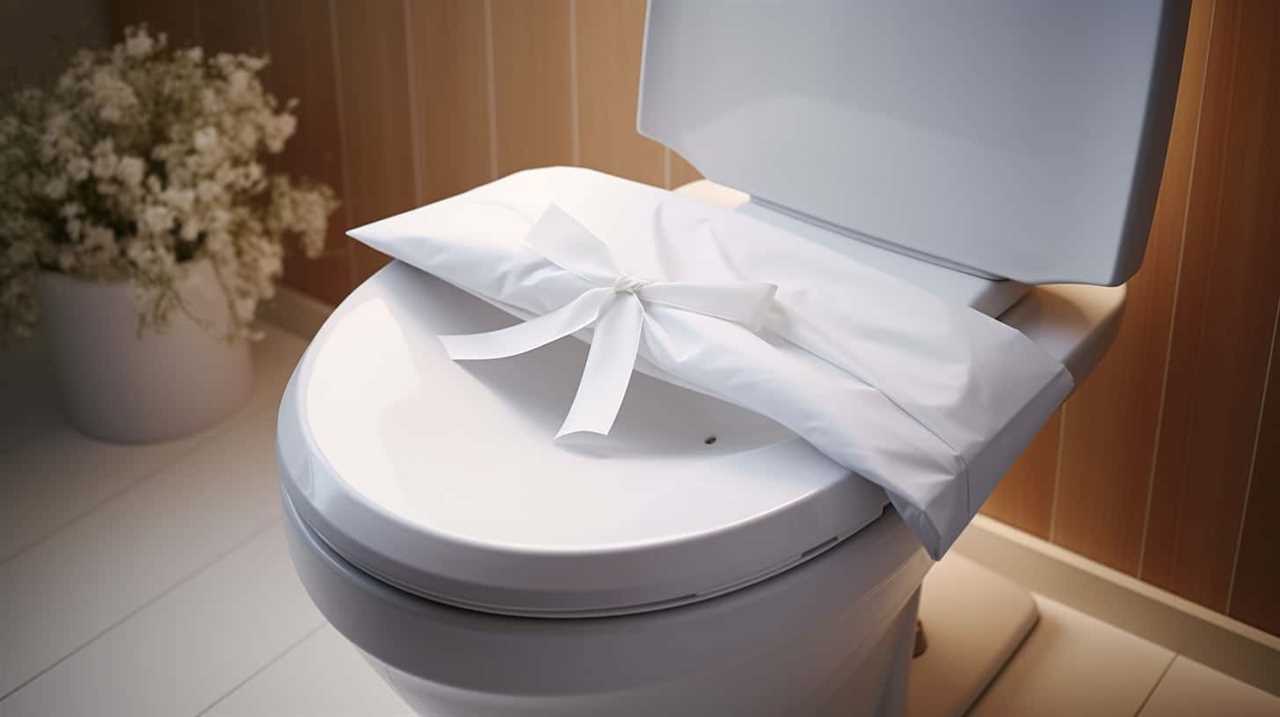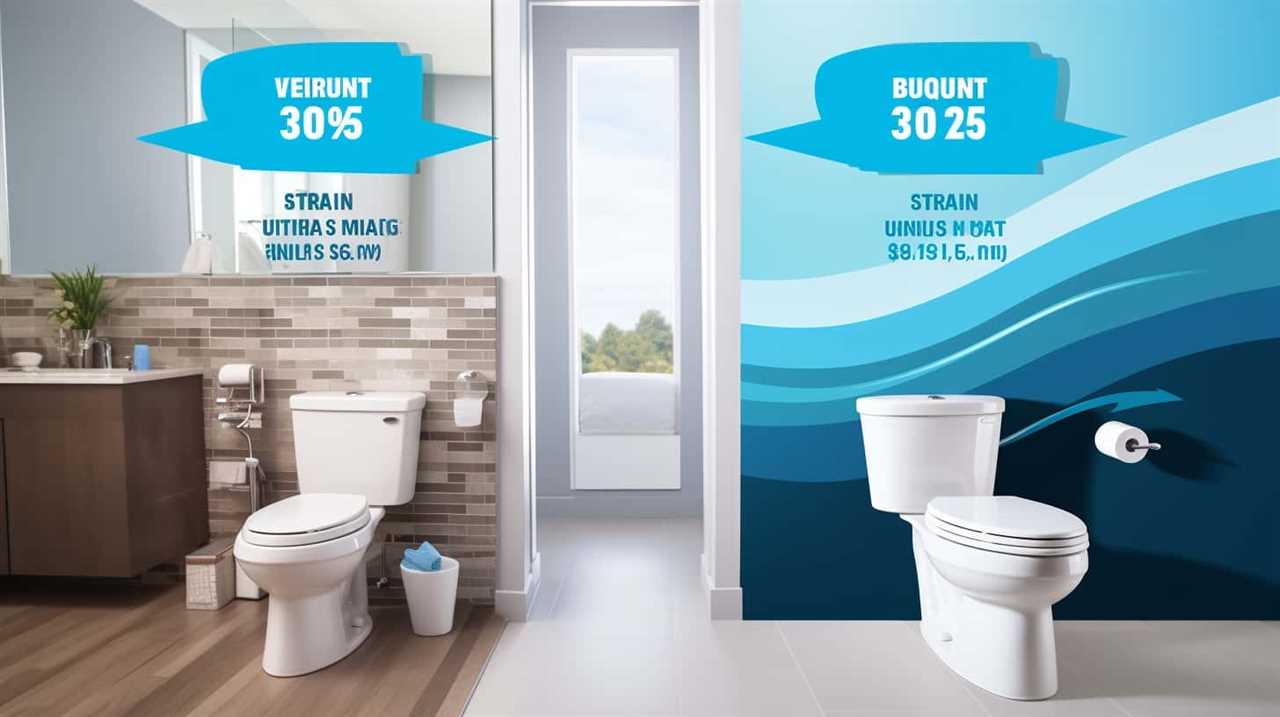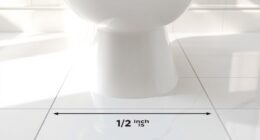Have you ever been baffled by the puzzling occurrence of a self-flushing toilet? Worry no more, as we have thoroughly explored this mystery to provide you with the explanations you’ve been looking for.
In this article, we will explore the various reasons why a toilet may flush on its own. These reasons include faulty flappers, water pressure issues, ghost flushing, malfunctioning sensors or floats, and even plumbing ventilation problems.
Get ready to uncover the secrets behind this intriguing occurrence!
Key Takeaways
- Faulty flapper or valve can cause improper sealing and water leakage, leading to self-flushing.
- Low water flow due to pressure regulator issues or blockages in the water supply line can contribute to self-flushing.
- Ghost flushing can occur due to water pressure fluctuations or a faulty flapper valve.
- Malfunctioning sensors or floats can cause random flushing, and regular maintenance is necessary to prevent this issue.
Faulty Flapper or Valve
We have found that a common reason for a toilet flushing itself is a faulty flapper or valve. The flapper is a rubber or plastic component that sits at the bottom of the tank and seals the flush valve opening. Over time, the flapper can deteriorate, causing it to not seal properly. This can lead to water leaking from the tank into the bowl, resulting in the toilet flushing itself.

To fix this issue, a flapper replacement is necessary. It’s a simple maintenance task that involves removing the old flapper and installing a new one.
Additionally, regular valve maintenance is crucial to prevent toilet flushing problems. Ensuring that the valve is clean and properly adjusted can help maintain proper flushing functionality.
Water Pressure Issues
To address the issue of a toilet flushing itself, it is important to consider the potential role of water pressure issues. Low water flow and clogged pipes can both contribute to a toilet flushing on its own. Low water flow can occur due to various reasons, such as a malfunctioning pressure regulator or a blockage in the water supply line. Clogged pipes, on the other hand, can cause water to back up and create pressure that triggers the flushing mechanism. Here is a table summarizing the potential causes and solutions for water pressure issues in toilets:
| Potential Cause | Solution |
|---|---|
| Low water flow | Check pressure regulator and water supply line for issues. |
| Clogged pipes | Use a plunger or plumbing snake to clear the blockage. |
Understanding the role of water pressure issues is crucial in diagnosing and resolving the problem of a toilet flushing itself. This leads us to the next section, where we will explore the phenomenon of ‘ghost flushing’.

Ghost Flushing
As we delve further into the topic of toilet flushing itself, we must now explore the phenomenon known as ‘ghost flushing’, which is closely related to water pressure issues. Ghost flushing refers to the unexplained flushing of a toilet without any apparent reason or human interaction. It’s often associated with paranormal activity and the notion of a haunted bathroom. Here are three important points to consider regarding ghost flushing:
- Water pressure fluctuations: Ghost flushing can occur when there are irregularities in water pressure, causing the toilet to flush spontaneously.
- Faulty flapper valve: A malfunctioning flapper valve can also lead to ghost flushing. If the flapper valve doesn’t seal properly, water can slowly leak into the bowl, triggering an automatic flush.
- Air pressure changes: Changes in air pressure, such as a sudden drop or increase, can create enough force to trigger a ghost flush.
Understanding the possible causes of ghost flushing can help homeowners address this eerie phenomenon.
Now, let’s move on to discuss another potential reason for a toilet flushing itself: malfunctioning sensor or float.
Malfunctioning Sensor or Float
One possible cause for a toilet flushing itself is a malfunctioning sensor or float. The sensor and float work together to detect the water level in the toilet tank and control the flushing mechanism. If the sensor isn’t calibrated correctly or if the float is damaged, it can result in the toilet flushing randomly without any input.

To fix this issue, sensor calibration may be required to ensure accurate water level detection. Regular maintenance is also crucial to prevent sensor or float malfunction. This includes cleaning the sensor and float regularly and checking for any signs of damage or wear. By following these maintenance tips, you can reduce the likelihood of a malfunctioning sensor or float causing your toilet to flush itself.
Now, let’s move on to the next section and discuss plumbing ventilation problems.
Plumbing Ventilation Problems
Moving on from the previous subtopic of a malfunctioning sensor or float, we’ll now address the issue of plumbing ventilation problems. Proper ventilation is crucial for maintaining a healthy and functional plumbing system. Here are three key aspects related to plumbing ventilation problems:
- Mold growth: Inadequate ventilation can lead to excessive moisture buildup, creating an ideal environment for mold growth. Mold not only poses health risks but can also damage your plumbing system over time.
- Odor control: A properly ventilated plumbing system helps to control unpleasant odors that can arise from sewage gases. These gases can be harmful and cause discomfort if not properly vented out.
- Airflow balance: Ventilation ensures the proper flow of air within the plumbing system, preventing issues like water siphoning, slow drainage, or gurgling noises. This maintains the optimal functionality of your plumbing fixtures.
To avoid these problems, it’s essential to ensure that your plumbing ventilation system is well-designed, free from blockages, and properly maintained.

Frequently Asked Questions
How Can I Fix a Faulty Flapper or Valve in My Toilet?
To fix a faulty flapper or valve in our toilet, we should first locate the problem. If there are toilet clogs or water leakage, it’s likely the flapper or valve needs replacing.
What Are the Common Signs of Water Pressure Issues in Toilets?
When experiencing water pressure issues in toilets, common signs include weak flushing, slow filling, and inconsistent water levels. These problems can be caused by a faulty toilet flapper or inadequate water pressure.
Can Ghost Flushing Occur in All Types of Toilets?
Ghost flushing can occur in all types of toilets. It is a phenomenon where the toilet mysteriously flushes on its own, without any human interaction. This paranormal activity can leave us puzzled and questioning the forces at play.
How Can I Identify if the Sensor or Float in My Toilet Is Malfunctioning?
To troubleshoot a malfunctioning toilet sensor or float, we can check for water level issues, inspect the float for damage or debris, and ensure the sensor is properly aligned and connected.

What Are the Consequences of Plumbing Ventilation Problems in Toilets?
Plumbing ventilation problems in toilets can lead to improper flushing, causing various consequences. To resolve this issue, we recommend implementing plumbing ventilation solutions to ensure proper airflow and prevent any negative impact on the toilet system.
Conclusion
In conclusion, when a toilet flushes itself, it’s often due to a faulty flapper or valve, water pressure issues, ghost flushing, malfunctioning sensor or float, or plumbing ventilation problems.
These causes can disrupt the normal functioning of the toilet, leading to unexpected flushes.
Just like a mischievous poltergeist, the toilet operates on its own accord, surprising us with its unwarranted actions.

Therefore, it’s crucial to address these issues promptly to restore the toilet to its intended purpose.










